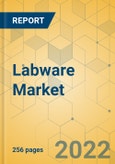Speak directly to the analyst to clarify any post sales queries you may have.
Factors such as the increasing number of R&D laboratories, rising demand for plasticware and glassware products for clinical use in hospitals and forensic laboratories as they are lightweight, recyclable, cost-effective, and non-breakable, and government support in the field of pharmaceutical and drug discovery are anticipated to be the key drivers for the growth of the global labware market in the coming years.
MARKET GROWTH ENABLERS
- Increasing Demand for Plastic Labware
- Rising Research in Biotechnology & Pharmaceutical Industries
- Investment in Plastic Labware
LABWARE MARKET SEGMENTS
By end-user, the market is classified into research & academic institutions, hospitals & diagnostic centers, biotechnology industry & pharmaceutical, contract research organizations, food & beverage industry, and others. The research & academic institutions segment is the largest segment and accounted for a revenue share of 30.18% in 2021.
The pipettes segment dominated the market and accounted for a highest share in 2021.
Segmentation by Product
- Pipettes
- Burettes
- Beakers
- Flasks
- Test Tubes
- Others
Segmentation by Material Type
- Plasticware
- Glassware
- Disposable
- Others
Segmentation by End-User
- Research & Academic Institutions
- Hospitals & Diagnostic Centers
- Biotechnology Industry & Pharmaceutical
- Contract Research Organization
- Food & Beverage Industry
- Others
GEOGRAPHICAL ANALYSIS
In North America, the rising number of diagnostic tests, increased usage of laboratory consumables, and introduction of specially designed plasticware are key factors that are driving the growth of the market in the region.
The APAC labware market is the fastest growing in the world. Developing countries such as India are planning to initiate a nearly $1.3 billion fund to encourage businesses to manufacture pharmaceutical ingredients domestically by 2023. The country supplies a substantial share of the global demand for multiple vaccines and accounts for the second-largest pharmaceutical and biotech workforce globally.
Segmentation by Geography
- North America
- US
- Canada
- Europe
- Germany
- France
- UK
- Italy
- Spain
- APAC
- China
- Japan
- India
- South Korea
- Australia
- Latin America
- Brazil
- Mexico
- Argentina
- Middle East & Africa
- South Africa
- UAE
COMPETITIVE ANALYSIS
The growth of players in the market depends on its condition, economic growth, and industry development. Exporting through an intermediary such as a distributor or importer is still the key channel for exporters from developing countries.
Key Vendors
- Corning
- DWK Life Sciences
- Bellco Glass
- Thermo Fisher Scientific
- Sartorius
Other Prominent Vendors
- Eppendorf
- METTLER TOLEDO
- Borosil
- TECHNOSKLO
- Crystalgen
- Eagle Laboratory Glass Company
- Sarstedt
- PerkinElmer
- Hamilton Laboratory Glass
- Quark
- Kavalierglass
- Glacier Glass Works
- Jencons Glass Industries
- Glassco
- HARIO
- CITOTEST
- SP Industries
- SCAM
- Merck
- Naugra Export
THE REPORT INCLUDES:
1. The analysis of the Global Construction Adhesives market provides market size and growth rate for the forecast period 2022-2027.
2. It offers comprehensive insights into current industry trends, trend forecast, and growth drivers about the Global Construction Adhesives market.
3. The report provides the latest analysis of market share, growth drivers, challenges, and investment opportunities.
4. It offers a complete overview of market segments and the regional outlook of the Construction Adhesives market.
5. The report offers a detailed overview of the vendor landscape, competitive analysis, and critical market strategies to gain competitive advantage.
Table of Contents
Companies Mentioned
- Corning
- DWK Life Sciences
- Bellco Glass
- Thermo Fisher Scientific
- Sartorius
- Eppendorf
- METTLER TOLEDO
- Borosil
- TECHNOSKLO
- Crystalgen
- Eagle Laboratory Glass Company
- Sarstedt
- PerkinElmer
- Hamilton Laboratory Glass
- Quark
- Kavalierglass
- Glacier Glass Works
- Jencons Glass Industries
- Glassco
- HARIO
- CITOTEST
- SP Industries
- SCAM
- Merck
- Naugra Export
Methodology
Our research comprises a mix of primary and secondary research. The secondary research sources that are typically referred to include, but are not limited to, company websites, annual reports, financial reports, company pipeline charts, broker reports, investor presentations and SEC filings, journals and conferences, internal proprietary databases, news articles, press releases, and webcasts specific to the companies operating in any given market.
Primary research involves email interactions with the industry participants across major geographies. The participants who typically take part in such a process include, but are not limited to, CEOs, VPs, business development managers, market intelligence managers, and national sales managers. We primarily rely on internal research work and internal databases that we have populated over the years. We cross-verify our secondary research findings with the primary respondents participating in the study.

LOADING...








